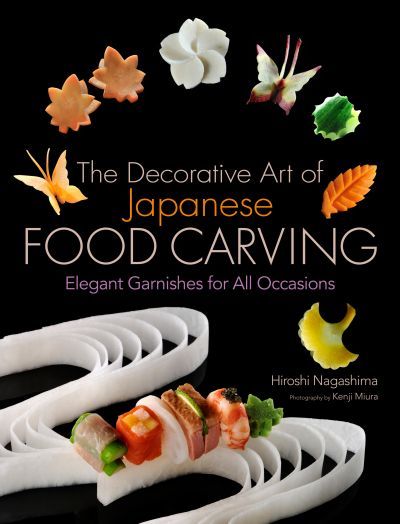Chef shows how to turn food into works of art

Japanese food is renown for its elegant presentation and artistic aesthetics, but chef Hiroshi Nagashima has taken that tradition to new heights with a new book that shows the uninitiated how to turn a slice of grapefruit peel into an elegant swan-shaped dish to hold a dessert or a humble radish into a rosebud design.
A key element of any meal in Japan is " mukimono" - the decorative garnish or carving that adds a final flourish to a dish. Designed to catch the eye and provoke conversation for its shape and color, it is also completely edible.
Nagashima is head chef and managing director of Shisui Restaurant in Tokyo's Tsukiji district - famous for its vast fresh fish market - and has authored several books on traditional Japanese cuisine, as well as being awarded the National Culinary Master's Technique for Excellence Award.
His latest work, The Decorative Art of Japanese Food Carving: Elegant Garnishes for all Occasions, contains precise instructions for 60 food carvings and garnishes as well as ideas on food arrangement. Most are simple while some require practice. One or two, however, are bordering on professional level.
Divided into four parts, the first section is dedicated to more simple accents - making it a good place for the novice to cut their teeth.
One of the easiest maneuvers consists of making twists of carrot, cucumber or "daikon" radish that add a splash of color to any plate. The ocean wave curl is slightly more testing and requires slits to be carefully made in a thin slice of carrot, while a series of knots can also be made out of the same vegetables.
Food cups can be made out of limes - which go perfectly with slices of roast duck or seasoned calamari with salmon caviar. A pumpkin can also be carefully cut to create what Nagashima describes as a jewel box that can contain shrimps, mushrooms or asparagus.
Several pages of the book are dedicated to the remarkably flexible cucumber, which can be carved into miniature cups, crowns, cranes, boats, fans, rings baskets and even corkscrews.
Nagashima also demonstrates how to turn strips of daikon into a flowing river upon which morsels are served up, while it can also double as a leaf of wisteria. More complicated is the fish net, made up of strips of zucchini manipulated into a mesh and stuffed with salmon mousse.
With the aid of dozens of photos, the chef also shows how a carrot can be worked into a rolling dice, a plum blossom or a Chinese bellflower, while others become delicately carved leaves or even a chrysanthemum.
At the more challenging end of the scale, Nagashima can create holly leaves from a zucchini, a flying swallow or even butterflies and goldfish out of a slice of carrot.
Published by Kodansha International Ltd., the book is available in Japan and the United States for $24.95. Elsewhere, it is available online.
JR
Subscribe to Independent Premium to bookmark this article
Want to bookmark your favourite articles and stories to read or reference later? Start your Independent Premium subscription today.

Join our commenting forum
Join thought-provoking conversations, follow other Independent readers and see their replies